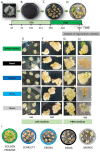The improvement of the in vitro plant regeneration in barley with the epigenetic modifier of histone acetylation, trichostatin A
- PMID: 37962803
- PMCID: PMC10789698
- DOI: 10.1007/s13353-023-00800-9
The improvement of the in vitro plant regeneration in barley with the epigenetic modifier of histone acetylation, trichostatin A
Abstract
Genotype-limited plant regeneration is one of the main obstacles to the broader use of genetic transformation in barley breeding. Thus, developing new approaches that might improve responses of in vitro recalcitrant genotypes remains at the center of barley biotechnology. Here, we analyzed different barley genotypes, including "Golden Promise," a genotype commonly used in the genetic transformation, and four malting barley cultivars of poor regenerative potential. The expression of hormone-related transcription factor (TF) genes with documented roles in plant regeneration was analyzed in genotypes with various plant-regenerating capacities. The results indicated differential expression of auxin-related TF genes between the barley genotypes in both the explants and the derived cultures. In support of the role of auxin in barley regeneration, distinct differences in the accumulation of free and oxidized auxin were observed in explants and explant-derived callus cultures of barley genotypes. Following the assumption that modifying gene expression might improve plant regeneration in barley, we treated the barley explants with trichostatin A (TSA), which affects histone acetylation. The effects of TSA were genotype-dependent as TSA treatment improved plant regeneration in two barley cultivars. TSA-induced changes in plant regeneration were associated with the increased expression of auxin biosynthesis-involved TFs. The study demonstrated that explant treatment with chromatin modifiers such as TSA might provide a new and effective epigenetic approach to improving plant regeneration in recalcitrant barley genotypes.
Keywords: Barley; Hormones level; Plant regeneration; Transcription factors; Trichostatin A.
© 2023. The Author(s).
Conflict of interest statement
The authors declare no competing interests.
Figures







Similar articles
-
Transcriptomic profiling reveals histone acetylation-regulated genes involved in somatic embryogenesis in Arabidopsis thaliana.BMC Genomics. 2024 Aug 15;25(1):788. doi: 10.1186/s12864-024-10623-5. BMC Genomics. 2024. PMID: 39148037 Free PMC article.
-
Identification of regulatory factors promoting embryogenic callus formation in barley through transcriptome analysis.BMC Plant Biol. 2021 Mar 19;21(1):145. doi: 10.1186/s12870-021-02922-w. BMC Plant Biol. 2021. PMID: 33740900 Free PMC article.
-
Trichostatin A Triggers an Embryogenic Transition in Arabidopsis Explants via an Auxin-Related Pathway.Front Plant Sci. 2018 Sep 13;9:1353. doi: 10.3389/fpls.2018.01353. eCollection 2018. Front Plant Sci. 2018. PMID: 30271420 Free PMC article.
-
Epigenomics in stress tolerance of plants under the climate change.Mol Biol Rep. 2023 Jul;50(7):6201-6216. doi: 10.1007/s11033-023-08539-6. Epub 2023 Jun 9. Mol Biol Rep. 2023. PMID: 37294468 Review.
-
Involvement of histone acetylation and deacetylation in regulating auxin responses and associated phenotypic changes in plants.Plant Cell Rep. 2018 Jan;37(1):51-59. doi: 10.1007/s00299-017-2205-1. Epub 2017 Sep 25. Plant Cell Rep. 2018. PMID: 28948334 Review.
Cited by
-
Multi-omics analysis reveals the positive impact of differential chloroplast activity during in vitro regeneration of barley.Plant Mol Biol. 2024 Nov 13;114(6):124. doi: 10.1007/s11103-024-01517-x. Plant Mol Biol. 2024. PMID: 39538083
-
Insights into plant regeneration: cellular pathways and DNA methylation dynamics.Plant Cell Rep. 2024 Apr 18;43(5):120. doi: 10.1007/s00299-024-03216-9. Plant Cell Rep. 2024. PMID: 38634973 Free PMC article. Review.
-
Small molecules, enormous functions: potential approach for overcoming bottlenecks in embryogenic tissue induction and maintenance in conifers.Hortic Res. 2024 Jul 10;11(8):uhae180. doi: 10.1093/hr/uhae180. eCollection 2024 Aug. Hortic Res. 2024. PMID: 39108576 Free PMC article. Review.
References
-
- Aguado-Santacruz GA, Velázquez-Ordinola Á, Moreno-Gómez B, et al. Development of long-term and reliable in vitro plant regeneration systems for elite malting barley varieties: optimizing media formulation and explant selection. Afr J Biotechnol. 2011;10:19522–19533. doi: 10.5897/AJB11.1736. - DOI
-
- Alemanno L, Berthouly M, Michaux-Ferribre N. Histology of somatic embryogenesis from floral tissues cocoa. Plant Cell Tissue Organ Cult. 1996;46:187–194. doi: 10.1007/BF02307094. - DOI
-
- Anjanappa RB, Gruissem W (2021) Current progress and challenges in crop genetic transformation. J Plant Physiol 261:1–13 10.1016/j.jplph.2021.153411 - PubMed
MeSH terms
Substances
Grants and funding
LinkOut - more resources
Full Text Sources
Research Materials
Miscellaneous

